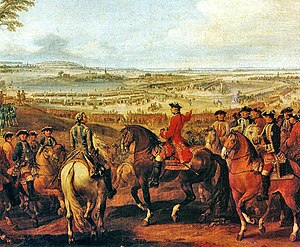Battle of Lauffeld
| Battle of Lauffeld | |||||||
|---|---|---|---|---|---|---|---|
| Part of the War of the Austrian Succession | |||||||
 Marshal Maurice de Saxe at the Battle of Lauffeldt. Contemporary painting by Pierre Lenfant. | |||||||
| |||||||
| Belligerents | |||||||
|
|
| ||||||
| Commanders and leaders | |||||||
|
|
| ||||||
| Strength | |||||||
| 60,000 | 80,000 | ||||||
| Casualties and losses | |||||||
| 8,000[1] | 9,000 | ||||||
The Battle of Lauffeld (a.k.a. Battle of Lafelt or Battle of Maastricht, also Battle of Val) took place on July 2, 1747,[2] during the French invasion of the Netherlands (part of the War of the Austrian Succession). Marshall Saxe led the French forces against the combined forces of the Scots Guards under the banner of the Duke of Cumberland, and the Dutch Republic, fighting under the Prince of Orange, at Lauffeld (or Lafelt, now part of Riemst), just west of Maastricht.
Cumberland attempted to defeat a detachment of the French army commanded by the Prince of Clermont but a forced-march by Saxe outmanuvered him. Cumberland now faced the entire French army but further compromised his chances of success by ignroing Ligonier's advice to occupy and fortify a line of villages across the front of the allied army. Once again, as at the Battle of Rocoux the Austrians on the right refused to move against the open French flank. The villages changed hands a few times until Saxe gained the upper hand. The Dutch broke and fled and a general French advance threatened the annihilation of the British infantry. General Ligonier then led a cavalry charge that saved the army, but he was captured along with four standards.[3]
Celebrated by the French as a victory, the Allied army was not decisively defeated. It had retreated in an orderly fashion, leaving the French the battlefield, but stopping them from immediately capturing Maastricht. However, the allied retreat allowed Saxe to send a detachment of 30,000 that quickly captured the city of Bergen-op-Zoom to finish that year's campaign season. At the opening of the Spring campaign season of 1748, the French invested Maastricht and, after a brief siege the city fell on May 7. The city's capture started the peace process in April that ended the war in October with the Treaty of Aix-la-Chapelle in 1748.
References
- ^ History of England, Phillip Henry Stanhope, p. 333, "The number of killed and wounded, on both sides, was very great, and nearly equal."
- ^ Williams, Hywel (2005). Cassell's Chronology of World History. Weidenfeld & Nicolson. ISBN 0-304-35730-8.
- ^ History of England, Phillip Henry Stanhope, p. 334
